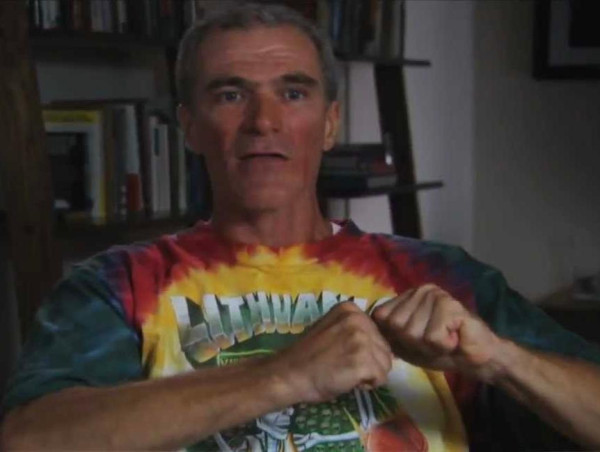The Lithuanian Olympic Men’s Basketball Team showed up on the medal platform, wearing the way-out Skullman® tie-dyed basketball uniforms after clinching the bronze medal in the men's basketball competition at the 1992 Summer Olympic Games in Barcelona, Spain. They wowed the world, and it turned out to be something that was never before seen in the world of Olympic sports uniforms fashion.
The Slammin' Skeleton Lithuanian Basketball uniforms were created by NYC apparel brand designer Greg Speirs for the team just to have something fun to wear during the Olympics practice time before the actual Olympic Games. Wearing the "Skullman Tie Dyes" energized and inspired the team. After seeing the artist's T-Shirts worn by the team on the bronze medal platform the reaction from the international Olympics audience was overwhelming. The players wore the shirts wherever they went after that. Then the public wanted to know where they could buy one.
“The story became a major news event impacting popular culture, taking its place in Olympics history, had a major influence on the future of sports fashion and changed it forever. The Tie Dyed Slammin®Skullman® became a legendary household icon.” said Mike Thompson of Slammin Sports®.
“It’s really difficult to understand the magnitude and the significance and the impact and the power of what went down with those shirts.” said NBA Hall of Famer Bill Walton. - Gannett News
“With those t-shirts, we were like the new kids on the block,” explained Rimas Kurtinaitis, a starting wing for the team who is now head coach of Lithuania’s BC Wolves.
The 1992 story:
The story began when Lithuania, one of the Baltic States' former Soviet Satellite countries, during the time of the Reagan administration, broke from the Soviet Union and gained it's newly found independence and freedom. Former Soviet player and then NBA star Sarunas Marciulionis, who was discovered by a coach at the Golden State Warriors, started rallying for donations and support for the new but financially strapped 1992 Lithuanian Olympic Men's Basketball team, with hopes of competing for the first time as a free nation apart from the Soviet Union in the 1992 Summer Olympics in Barcelona, Spain. Marciulionis received various monetary donations, including one from the Grateful Dead musical group. According to news reports, among the various donations the team received the Grateful Dead came into the story with a separate $5,000. donation of their own to Marciulionis, which was the part they played in this story.
New York Licensor and apparel designer Greg Speirs also heard about the team's plight and came into this story and independently created the Skullman®Lithuania Tie Dye® basketball t-shirts just so the team could have something fun to wear during the practice time before the actual Olympic competitions.
Listen to the podcast that uncovered the complete, true facts about the t-shirts: https://wondery.com/shows/sports-explains-the-world/episode/13843-the-skullman-cometh/
Watch the YouTube Documentary: https://youtu.be/MsbJg8iJNYE?feature=shared
During the awarding ceremony, Lithuanians decided to dress up in the colorful Skeleton Jerseys in order to show their newly reborn country national colors and to show their gratitude to Greg Speirs and the Grateful Dead for their financial support. Rimas Kurtinaitis characterized the emotional awarding ceremony by saying: "Well, we cried. It was really from joy. Words cannot even express feelings like that. You need to be there". Valdemaras Chomičius: "It was such an emotion that it's hard to explain. You have to experience it". Arvydas Sabonis by comparing his 1988's Olympic gold medal and the 1992's Olympic bronze medal said: "The medal in Seoul was gold, but this bronze is our soul". In all, Lithuanians averaged 94 points per game in the tournament, being outclassed only by the USA (117 points per game). from Wikipedia (Lithuania men's national basketball team: History)
The team's plight was highlighted in the 2012 sports and political documentary film "The Other Dream Team", Directed and produced by Marius Markevicius and Jon Weinbach, The film is about the Lithuanian Olympic basketball team's road to the 1992 Summer Olympic Games. The film highlights these elite athletes’ experiences behind the Iron Curtain, where they were subjected to the brutalities of Communism. Hiding from KGB agents and feared for their lives, Lithuania’s basketball stars always shared a common goal – to utilize their athletic gifts to help free their country. Aside from the hardships on the road to the '92 Olympics, the film celebrates Greg Speirs' iconic tie-dyed uniforms worn by the team, now an historic piece of Summer Olympics' basketball history.
See IMDB bio:
http://www.imdb.com/name/nm3998173/
Listen to "The Other Dream Team" interview:
http://www.gregspeirs.com/greg-speirs-audio-interview-by-the-other-dream-team-documentary-film/
Read the news doc. facts.:
https://www.amworldgroup.com/blog/lithuanian-slam-dunking-skeleton-back-for-the-other-dream-team-documentary
Where the uniforms came from:
"The Skullman® Lithuania tie dye®basketball shirts are actually an independent apparel line brought into this story, created and solely owned by the designer. It was never an actual team jersey, nor was it ever part of the Grateful Dead. It is a bona fide licensed brand owned exclusively by the designer. All licensing rights for the property and brand always originated exclusively from the designer right from the beginning in 1992.” said Mike Thompson of Slammin' Sports.
"The designer played a much more significant role in the story of the Lithuanian Olympic Basketball Team than was first reported in 1992, including with respect to the funding of the Lithuanian team. Skewed misreports are often still picked up today by major newspapers based on the initial 1992 debunked and uncorrected narratives put forth. But the true facts about the accurate source of the famous jerseys are finally being brought to light." recalled Mike Thompson of Slammin' Sports.
“It is a much less romantic version of the story,” McNally admitted. “That’s the story that everybody constantly ignores. It was just Grateful Dead serendipity … We got a lot of credit that we didn’t deserve.” said Grateful Dead spokesman Dennis McNally. Speirs feels similarly when he reflects on how previous versions were told. “It’s such a great story that maybe those reporting wanted the story to be the way they wished it would have been or the way they really wanted the story to be,” Speirs said. “Like a feel good fantasy but not in reality or with correct facts.” McNally admits that the narrative these days is too often personalized to credit Grateful Dead frontman Jerry Garcia, who he said didn’t even pay much attention to basketball. McNally said the band is credited with “genius marketing” on this project even though the first round of memorabilia contained no band logos, nor was it directly funded by the Grateful Dead. - USA Today
"But the real story with the real facts is still a great story nonetheless." added the artist
About Greg Speirs:
He is the former art director who created the rock n’ roll music magazine “Grooves” back in the 1970’s, designed the legendary "Monaco Monk" icicle sleds for Prince Albert of Monaco and his Olympic Monaco Bobsled Team used in the 1998 Nagano Winter Olympics & 1995 World Cup and collaborated in the 1970's with famed Woodstock Music Festival founder and record producer Artie Kornfeld, in particular with RCA Records. Awards: Named to Society Of Illustrator's top 500 Illustrators in America Annuals 1975 and 1976. Named to Who's Who in America and Who's Who in the World.
"When the Olympics ended and demand for the shirts continued, Greg saw it as a great opportunity to help the team and chose to donate all of what would have been his profits to continue to fund the team. He licensed to the team use of his property (the shirts) to sell t-shirts for a limited time to raise money to sponsor the team and for Marciulionis' additional charities. That's why Greg is called the major sponsor of the 1992 Men's Lithuanian Olympic Basketball Team after the Olympics. He donated 100% of his profits to sponsor the team, which was the original $450,000 in the first wave of charity donated to the team (reported by Forbes Magazine) which continued sponsoring the team after the Olympics with more continuing profits going to Marciulionis and his charities which may have skyrocketed to millions according to news reports. All of the rest of Greg's profits were given to Lithuanian player Sarunas Marciulionis and the "Sarunas Lithuanian Children’s Fund" to help sick children in need, which was set up and controlled by the former Lithuania team player and NBA star who received 100% of all remaining funds with a portion used to fund Marciulionis' basketball school in Lithuania according to news reports." recalled Mike.
Any donation of funds given from the sale of a shirt ultimately came from the artist. The documented fact is that after the Olympics ended, as Licensor, it was his money that became the biggest donation to the team, to Marciulionis, to his charity and to build Sarunas' basketball school in Lithuania, because those funds came from the sales of his shirts. Only Greg had the right to release profits to charity or to anyone. 100% of his licensing profits were released to fund the team, Marciulionis and his charities." said Mike.
“The 1992 Lithuanian Basketball Team represents what happens in freedom…people excel. The Lithuanian Slam-Dunking Skullman® represents rising from nothing. Like a Phoenix from the ashes to slam-dunking a flaming basketball. It's not a dead skeleton, but the Skullman is alive and represents rebirth and a new life. When you are free you have the opportunity to succeed as an individual while still being part of a team. It was not only a victory in Olympic sports, but it was as if it were an overall triumph over communism itself. It's about freedom and free enterprise." recalled Speirs.
The artist's uniforms were listed as one of the Ten Olympics Games' most memorable team uniforms in modern history in The National News' "Lifestyle/Luxury" article, by Sarah Maisey July 26, 2024.
The uniforms were “enshrined” in the Naismith Basketball Hall of Fame in Springfield, Mass. on Dec.7th 1993, below a giant 12ft. x 8ft. 3-D incarnation of the legendary Slam Dunking Skeleton. Marciulionis' jersey was also added to the collection by the Basketball Hall of Fame's curator Mike Brooslin at the time.
See link: http://www.lithuaniatshirt.com/basketball%20hall%20of%20fame.htm
Vintage editions of the shirts sell for hundreds of dollars online at sites like EBay. The Original 1992 Skullman Lithuania Tie Dye® T-Shirts and the 2024 Editions are available on the www.Skullman.com website. Some of the 2024 Collector's Editions even have Special Commemorative Patches and Embroideries.
Official Licensor of the Original Lithuania Tie Dye® Brand Apparel & Merchandise. 1992 © Copyright & Trademark® property of Greg Speirs. Lithuania Tie Dye® & the Lithuanian Slam Dunking Skeleton® and all related trademarks, indicia and symbols are Official Trademark Brands and Licenses of Greg Speirs. Official Licensor/ Exclusive Source. All licensing rights originate from their owner Greg Speirs. Copyright 1992. All rights reserved.
Mike Thompson
Slammin' Sports
[email protected]
Visit us on social media:
Facebook
X
LinkedIn
Instagram
Other
Legal Disclaimer:
EIN Presswire provides this news content "as is" without warranty of any kind. We do not accept any responsibility or liability for the accuracy, content, images, videos, licenses, completeness, legality, or reliability of the information contained in this article. If you have any complaints or copyright issues related to this article, kindly contact the author above.
![]()




_01_20_2025_01_56_33_740448.jpg)

